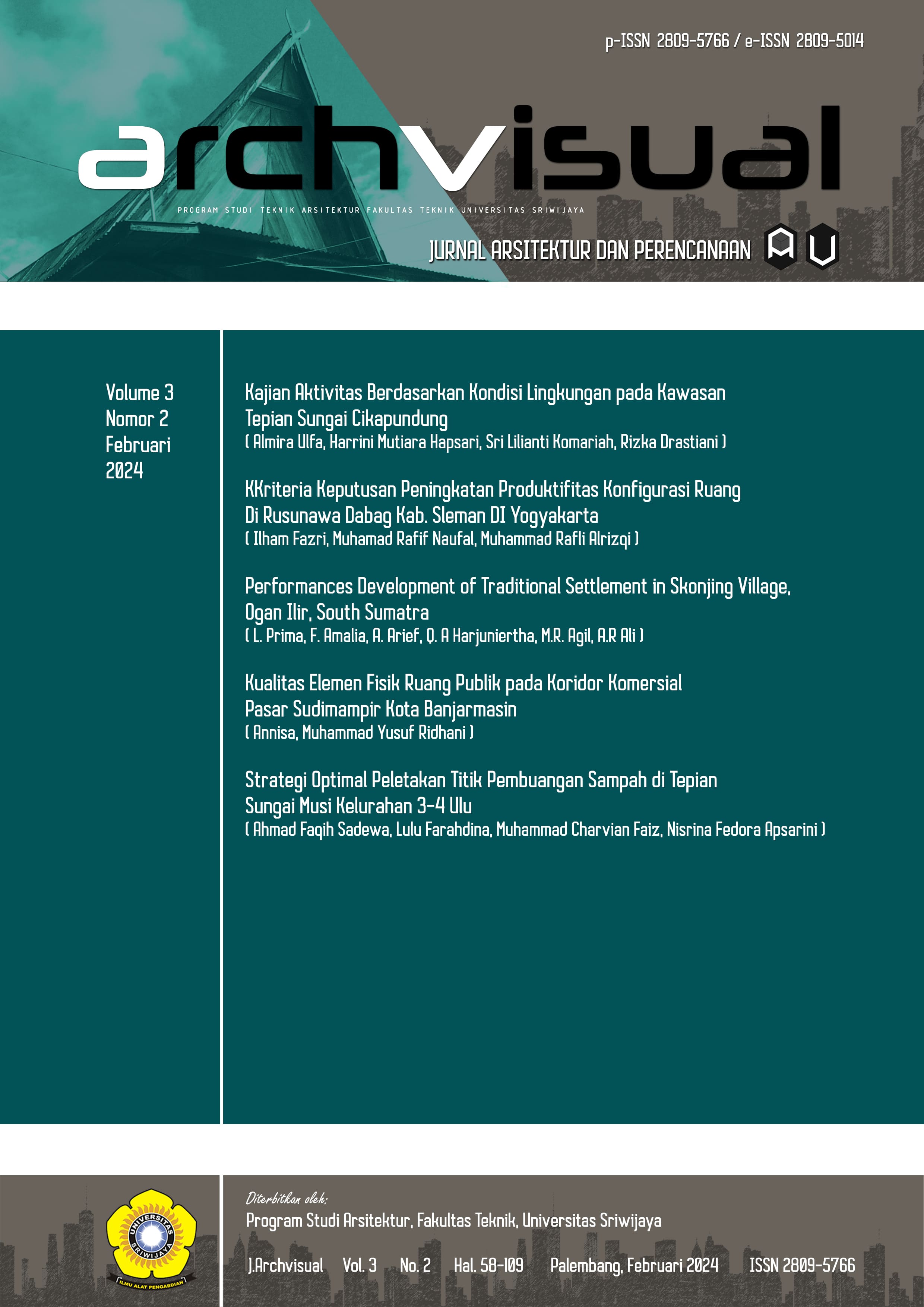Kajian Aktivitas Berdasarkan Kondisi Lingkungan pada Kawasan Tepian Sungai Cikapundung
Main Article Content
Abstract
The Riverside area has the potential to be developed into an interactive public space. The exciting thing about it is doing activities in places close to the water while enjoying its beauty and atmosphere. This study identifies activities in the Cikapundung River bank area, including necessary, optional, and social activities. Then, it was also identified whether the community involved the Cikapundung River bank area when carrying out the optional and social activities. The method used is qualitative research, using interviews and field observation. The results show that people who live directly adjacent to the river carry out activities with solid interactions with the Cikapundung River. Meanwhile, settlement areas close to the river but not directly adjacent have minimal interaction with the river. It was found that the location and the openness to the river greatly influenced whether or not people interacted with the river. The output of this study can be a basis for developing areas along river banks.
Article Details
Section

This work is licensed under a Creative Commons Attribution-NonCommercial 4.0 International License.
How to Cite
References
Bandung Kita (2021) Lestarikan Sungai Cikapundung, Komunitas Serlok Bantaran Indonesia Gunakan Kearifan Lokal - Semua Tentang Bandung, <https://bandungkita.id/2021/01/11/lestarikan-sungai-cikapundung-komunitas-serlok-bantaran-indonesia-gunakan-kearifan-lokal/>
Carr, S., Francis, M., Rivlin, L. G., & Stone, A. M (1992) Public Space, Cambridge University Press.
Do, D. T., Cheng, Y., Shojai, A., & Chen, Y (2019) Public Park behaviour in Da Nang: An investigation into how open space is used. Frontiers of Architectural Research, vol. 8, no. 4, pp. 454–470. <https://doi.org/10.1016/j.foar.2019.05.006>
Dwiputra, I. D., & Ardiani, N. A (2017) Preferensi Masyarakat dalam Memilih Karakteristik Taman Kota Berdasarkan Motivasi Kegiatan, Temu Ilmiah Ikatan Peneliti Lingkungan Binaan Indonesia (IPLBI), <https://doi.org/10.32315/ti.6.e061
Gehl, J. (2011) a.b. Life Between Buildings. Island Press>
Hamidah, N., Rijanta, R., Setiawan, B., & Marfai, M. A (2016) Analisis Permukiman Tepian Sungai yang Berkelanjutan, Kasus Permukiman Tepian Sungai Kahayan Kota Palangkaraya, INERSIA, vol. XI, no.I 1, pp. 13–24.
Jordan, N. A., & Ulimaz, M (2019) a.b. Hubungan Antara Perilaku Masyarakat dan Pembentukan Ruang Publik (Studi Kasus: Permukiman Tepi Sungai Manggar), BORDER Jurnal Arsitektur, vol. 1, no. 2
Lussetyowati, T., & Ulfa, A (2023) Sense of Place Pasar 16 Ilir Palembang, Archvisual: Jurnal Arsitektur Dan Perencanaan, vol. 2, no. 2, pp. 63–72.
Mardiah, W. M. R. W. N (2015) Compact Urban form for Sociability in Urban Neighbourhoods. International Journal of Social Science and Humanity, vol. 5, no. 10, pp. 822–826, <https://doi.org/10.7763/ijssh.2015.v5.564>
Mentayani, I (2019) Identitas Dan Eksistensi Permukiman Tepi Sungai Di Banjarmasin Identity and Existence Riverside Settlement of Banjarmasin, Prosiding Seminar Nasional Lingkungan Lahan Basah, vol. 4, pp. 497–502,
Portal Bandung (2021) Serlok Bantaran, Kawasan Konservasi Bambu di Bandung. <https://www.bandung.go.id/features/detail/21/serlok-bantaran-kawasan-konservasi-bambu-di-bandung>
Sarwono, J (2022) Quantitative, Qualitative and Mixed Method Research Methodology, <https://www.researchgate.net/publication/360403377>
Sastrawati, I (2003) a.b. Prinsip Perancangan Kawasan Tepi Air (Kasus: Kawasan Tanjung Bonga), Jurnal Perencanaan Wilayah Dan Kota , vol. 14, no. 3, pp. 95–117.
Whyte, H. (2001) a.b. The Social Life of the Small Urban Space, Project for Public Spaces.
Wijaya, J., & Herlambang, S (2022) Penataan Ruang Publik Tepi Sungai Untuk Menghidupkan Kembali Fungsi Sungai Kota Jakarta, Jurnal Sains, Teknologi, Urban, Perancangan, Arsitektur (Stupa), vol. 3, no.2, 1933. <https://doi.org/10.24912/stupa.v3i2.12384>

